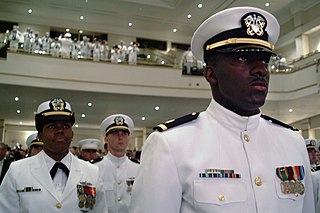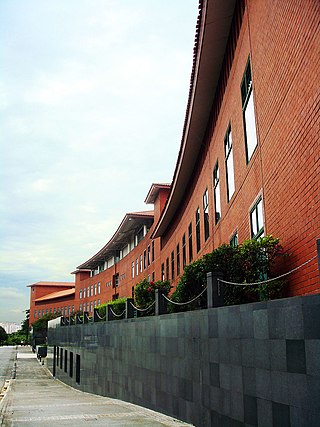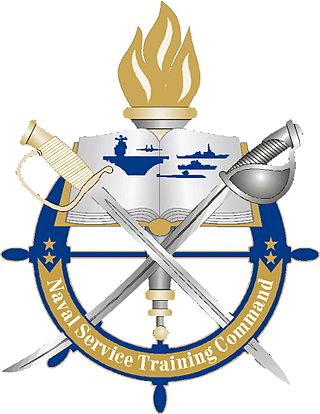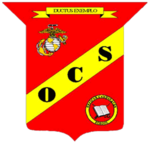
A non-commissioned officer (NCO) is a military officer who does not hold a commission. Non-commissioned officers usually earn their position of authority by promotion through the enlisted ranks. In contrast, commissioned officers usually enter directly from a military academy, officer training corps (OTC) or reserve officer training corps (ROTC), or officer candidate school (OCS) or officer training school (OTS), after receiving a post-secondary degree.

The Reserve Officer Training Corps is a group of college- and university-based officer-training programs for training commissioned officers of the United States Armed Forces.
An officer candidate school (OCS) is a military school which trains civilians and enlisted personnel in order for them to gain a commission as officers in the armed forces of a country. How OCS is run differs between countries and services. Typically, officer candidates have already attained post-secondary education, and sometimes a bachelor's degree, and undergo a short duration of training which focuses primarily on military skills and leadership. This is in contrast with a military academy which includes academic instruction leading to a bachelor's degree.

A drill instructor is a non-commissioned officer in the armed forces, fire department, or police forces with specific duties that vary by country. Foot drill, military step, and marching are typically taught by drill instructors.
Officer Cadet is a rank held by military cadets during their training to become commissioned officers. In the United Kingdom, the rank is also used by members of University Royal Naval Units, University Officer Training Corps and University Air Squadron; however, these are not trainee officers with many not choosing a career in the armed forces.

The Basic School (TBS) is where all newly commissioned and appointed United States Marine Corps officers are taught the basics of being an "Officer of Marines." The Basic School is located in Stafford County, Virginia to the south-west of the Marine Corps Base Quantico complex. Each year, over 1,700 new officers are trained, representing such commissioning sources as the U.S. Naval Academy, Navy ROTC, Officer Candidates School, and Marine Corps Limited Duty Officer (LDO) and Warrant Officer, U.S. Merchant Marine Academy accession programs.
Officer candidate or officer aspirant (OA) is a rank in some militaries of the world that is an appointed position while a person is in training to become an officer. More often than not, an officer candidate was a civilian who applied to join the military directly as an officer. Officer candidates are, therefore, not considered of the same status as enlisted personnel.

The United States Army's Officer Candidate School (OCS) is an officer candidate school located at Fort Moore, Georgia, that trains, assesses, and evaluates potential commissioned officers of the U.S. Army, U.S. Army Reserve, and Army National Guard. Officer candidates are former enlisted members, warrant officers, inter-service transfers, or civilian college graduates who enlist for the "OCS Option" after they complete Basic Combat Training (BCT). The latter are often referred to as college ops.

The Naval Reserve Officer Training Corps (NROTC) program is a college-based, commissioned officer training program of the United States Navy and the United States Marine Corps.

Marine Corps University is a military education university system of the United States Marine Corps. It is accredited by the Commission on Colleges of the Southern Association of Colleges and Schools to award Master's Degrees.

The United States Navy's Officer Candidate School provides initial training for officers of the line and select operational staff corps communities in the United States Navy. Along with United States Naval Academy (USNA) and Naval Reserve Officer Training Corps (NROTC), OCS is one of three principal sources of newly commissioned naval officers.

The Officer Cadet School (OCS) is a military training centre that trains commissioned officers for the four branches of the Singapore Armed Forces (SAF): the Army, the Navy, the Air Force, and the Digital and Intelligence Service. Located within the SAFTI Military Institute complex in Jurong West, it has twelve wings inclusive of tri-service wings. Nine wings are named according to the NATO phonetic alphabet from A (Alpha) to E (Echo) and S (Sierra) and T (Tango), while the remaining three wings are for the Navy, Air Force, and Digital and Intelligence Service, respectively. The trainees are mostly drawn from the best performing recruits in each basic military training cohort. Trainees with outstanding performance from the Specialist Cadet School (SCS), where specialists are trained, are also invited to transfer to OCS. Career soldiers may also attend OCS on application, recommendation and selection. OCS trainees are known as Officer Cadets (OCTs) if they serve in the Army and Air Force, Midshipmen (MIDs) if they serve in the Navy, and Senior Military Expert Trainees (ME4Ts) if they serve in the Digital and Intelligence Service.
A Marine Corps Officer Selection Officer (OSO) leads a team of Marines and civilian employees in the recruitment of college students and graduates for a Commission as a 2nd Lieutenant in the United States Marine Corps.

All branches of the United States Armed Forces use the general term Enlisted Professional Military Education (EPME) to describe the formal system of education which each branch provides to its enlisted personnel. Each branch has its own system and sequence of courses, with the overall focus on leadership and management. Education generally increases in intensity and level of knowledge as individuals progress in rank and assume broader leadership roles. EPME is distinct from the technical training which service members receive for their Military Occupational Specialty (MOS), Air Force Specialty Code (AFSC), or Navy Rating.

The Marine Forces Reserve, also known as the United States Marine Corps Reserve (USMCR) and the U.S. Marine Corps Forces Reserve, is the reserve force of the United States Marine Corps. It is the largest command, by assigned personnel, in the U.S. Marine Corps. Marines in the Reserve go through the same training and work in the same Military Occupational Specialties (MOS) as their active-duty counterparts. The United States Marine Corps Reserve was established when Congress passed the Naval Appropriations Act of 29 August 1916, and is responsible for providing trained units and qualified individuals to be mobilized for active duty in time of war, national emergency, or contingency operations.
The US Navy had four programs for the training of naval aviators.

An officer is a person who holds a position of authority as a member of an armed force or uniformed service.

The Army Reserve Officer Training Corps (AROTC) is the United States Army component of the Reserve Officers' Training Corps. It is the largest Reserve Officer Training Corps (ROTC) program which is a group of college and university-based officer training programs for training commissioned officers for the United States Army and its reserves components: the Army Reserves and the Army National Guard. There are over 30,000 Army ROTC cadets enrolled in 274 ROTC programs at major universities throughout the United States. These schools are categorized as Military Colleges (MC), Military Junior Colleges (MJC) and Civilian Colleges (CC).

Naval Officer Training Command Newport is a unit of Naval Education and Training Command, located on Naval Station Newport in Newport, Rhode Island that is responsible to the Chief of Naval Education and Training for the development of civilians, enlisted, and newly commissioned personnel for service in the fleet as Naval Officers. Outside of the requisite physical readiness testing, the programs are academic in nature, and with the exception of the student enrolled in the Naval Science Institute or Officer Candidate School, personnel will come to Officer Training School having already received their commission or warrant.

Naval Service Training Command (NSTC) is a one-star Echelon III command of the United States Navy that is responsible to the Chief of Naval Education and Training for the indoctrination and training of all new accessions into the Naval Service, with the exception of Midshipmen who access through the United States Naval Academy. This includes all new recruits through Recruit Training Command, the Navy's only enlisted recruit training location and all Officer "Candidates" who are seeking a commission through the Officer Training Command at Naval Station Newport, Rhode Island. Also under its purview is the operation of the various Naval Reserve Officers Training Corps (NROTC) units in universities across the country.
















